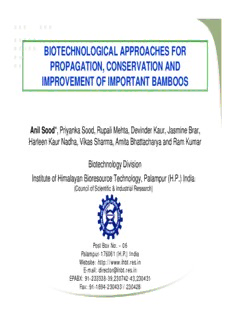
Sood, Anil - World Bamboo PDF
Preview Sood, Anil - World Bamboo
BIOTECHNOLOGICAL APPROACHES FOR PROPAGATION, CONSERVATION AND IMPROVEMENT OF IMPORTANT BAMBOOS Anil Sood*, Priyanka Sood, Rupali Mehta, Devinder Kaur, Jasmine Brar, Harleen Kaur Nadha, Vikas Sharma, Amita Bhattacharya and Ram Kumar Biotechnology Division Institute of Himalayan Bioresource Technology, Palampur (H.P.) India (Council of Scientific & Industrial Research) Post Box No. – 06 Palampur-176061 (H.P.) India Website: http://www.ihbt.res.in E-mail: [email protected] EPABX: 91-233338-39,230742-43,230431 Fax: 91-1894-230433 / 230428 Topics to be touched during the presentation: i. Bamboo micro-propagation ii. Conservation strategies iii. Genetic fidelity of TC raised plants iv. In vitro flower induction – for viable hybrid seeds? v. Field performance of TCPs vi. Possibilities of Genetic manipulations and overcoming the barriers. vii. Genetic diversity evaluation viii. Bamboo leaves as fodder ix. Acknowledgements IHBT Issues involved • Bamboos are considered non-timber forest produce and hence neglected. • No efforts are made to raise bamboo nurseries until recently. • Most of the bamboo plantations are in the private land and are grown through use of offsets. • Low commercial utilization of bamboos. • Gregarious flowering of Dendroclamus strictus, Bambusa bambos and Melocanna baccifera in many parts of the country creating social problems. • Bamboos extraction not done systematically and this damages the bamboo strands. • No survey reports about the actual assessment of bamboo stocks. • Being cross pollinated, natural variability is of common occurrence. • Variability in terms of low lignin and high cellulose is required by paper industry. • Greater need for generating planting materials with desired characteristics possibly through micro-propagation. IHBT Areas of focused attention at CSIR-IHBT Collection,Conservation and Characterization of bamboo germplasm Selection and propagation of elites both by macro- and micro- propagation Training in bamboo propagation and agro-technologies Improvement through seedling selections and transgenics Induction of bamboo flowering in vitro Setting up demonstration plots of TCPs Ensuring availability of planting stocks for the farmers, foresters, NGOs, and DRDA(District Rural Development Agency) IHBT Status of Bamboo Species at CSIR-IHBT In vitro grown species :Bambusa balcooa, B.bambos, B. multiplex, B. nutans, Dendrocalamus asper, D. giganteus, D.hamiltonii, D. membranaceus, Melocanna baccifera, Phyllostachys pubescens. Species grown in the nurseries : Arundinaria falconerii, Bambusa bambos, B. balcooa, B. distegia, B. multiplex, B. nutans,,|B.nana, B.pallida, B. tulda, B. ventricosa, B. vulgaris, Chimonobambusa quadrangularis, Dendrocalamus asper, D.barbatus, D. giganteus, D. hamiltonii, D. hookerii, D. membranaceus, D. sinicus, D. strictus, D. tibeticus, D. yunnanensis, Diongzhura tumidinoda, Guadua angustifolia, Ochlandra travancorica, Phyllostachys aurea, P. bambusoides, P. pubescens, P. nigra, Sasa auricoma, Melocanna baccifera, and Thyrsostachys siamensis. IHBT Micropropagation IHBT The micropropagation protocols for all the aforementioned bamboo species have been developed using either: i. Auxiliary bud proliferation using nodal explants of precocious branches and rooting or ii. Formation of compact and nodular callus, differentiation of somatic embryos, their germination and production of rooted plants. IHBT While efficient micropropagation systems (shoot cultures and somatic embryos) from lab to land were developed, protocols for slow growth of multiplying cultures were also standardized for efficient stock piling However, this requires strictly programmed schedules And therefore, methods for short and mid-term conservation were also standardized so as to ensure availability of mother stocks to meet the requirements. IHBT Selection of Elite Stocks - Seed collection from various locations. - Clump-wise germination in nursery beds. - Seedlings observed for 3-4 years in the fields for the following characteristics : – i) No. of culms produced annually, – ii) The length of culms, and – iii) Thickness of culms at the third internode from the base. - Selection of promising ones – (Year 2) - Final selection of elites – (Year 3) - Initiation of aseptic cultures using explants from thus selected field grown plus clumps. IHBT Micropropagation of D. hamiltonii a) Auxiliary bud proliferation and rooting Nodal Explant Sprouted Bud Multiple Shoots Rooting IHBT
Description: